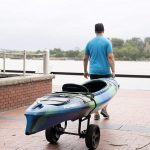Buckets, barrels, boxes and bags. Here's how you pack a kayak.

So you’ve bought your perfect kayak and got all the gear to go with it. So now what? Well, if you’re fortunate enough to live right next to the water, you can launch straight away and start enjoying kayaking. But for most people, there is a step between having your kayak in the garage and getting onto the water.
There are loads of different ways to transport a kayak, from the roof of your car to a trolley, or just carrying it with a partner. It might not be the most challenging part of kayaking, but there is still the potential to get this wrong and end up with your kayak damaged. Our guide to transporting your kayak will help you get to the water quickly and safely.
How do you Transport a Kayak?
The word transport will generally make you think of vehicles. Here though, we’re referring to transport as the process of getting your kayak from your house to the water. We’ll have a look at using vehicles shortly, but for now, we’re going to look at human-powered alternatives.
How to Carry a Kayak Safely and Efficiently
You’re often moving your kayak around before you’ve had a chance to get on the water and warm up. For that reason, you always want to make sure that you’re lifting your kayak safely.
However you plan to move your kayak, always lift it in a way that will protect your back from injury.
Bend your knees and keep your back straight as you lift. Try to keep the weight centered over your body so you’re not over-straining yourself.
Be cautious lifting and carrying your kayak in strong winds or over rough ground.
Carrying a Kayak with Two People
Perhaps the most common way to carry a kayak is with a partner. This lets you share the load and limits the excess strain on one person’s body, especially if you’re lifting up high.

For the most part, kayaks have grab handles at either end, making it easy to carry them as a pair. Some kayaks will carry better from the middle — either using central handles or the cockpit — so have a test and find out what balances your kayak the best.
When you’re carrying your kayak with two people, it’s important to remember the following things:
- Use the same lifting techniques as above to keep your back protected.
- Check that your partner is ready to lift and even have a countdown if it helps.
- The kayak may block a lot of vision from the person at the rear. The front carrier should do their best to make them aware of any hazards in the path.
- When you reach the water, lower the kayak gently back to the ground, again using a countdown if it helps you.
Carrying a Kayak Alone

Solo hauling a kayak is generally possible only with a sit-in kayak, rather than a sit-on-top. Using the cockpit, you can rest the kayak on your shoulder and it will balance there as you carry it.
With a little practice and some strong shoulders, you can carry a kayak long distances like this, with some white water explorers shouldering their kayaks for days to find the start of a river.
To lift your kayak up onto your shoulder, follow these steps:
- Lift the kayak from the front of the cockpit. Bend your knees and keep your back straight.
- Rotate the kayak so that it is standing upright on the stern — or as close as possible for longer kayaks — with the cockpit alongside your chosen shoulder.
- Place your shoulder insider the cockpit, roughly where your hip would be if you were inside it. Kayaks with hip pads make this easier.
- Once your shoulder is in place, use the same hand to hold the central pillar of your kayak and rotate the front end down until the kayak is balanced on your shoulder.
This may take a few practices, but don’t be tempted just to lift your kayak off the ground and straight onto your shoulder. You can follow these same steps in reverse to lower your kayak safely.
Using a Kayak Cart
If you need to move your kayak on your own, but it’s not suitable for carrying, you can always use a kayak cart. We have a whole article dedicated to the best kayak carts, so once you’re done here you can pick the right one for moving your kayak.

Kayak carts work especially well with a sit-on-top, or fishing-style kayak, where you will have plenty of space to stow them once you reach the water. With a narrower touring-style kayak, you can often stow it on the top deck — much easier if you buy a cart with removable wheels.
Load the kayak onto the cart by lifting one end and working the cart into place. The more central you place your cart, the better balanced your kayak will be.
If you’re going a long distance, or over rough terrain, it can be a good idea to strap your kayak to your cart for security.
Dragging a Kayak
It’s looked down on by a lot of kayakers, but there’s nothing wrong with dragging your kayak.
That is, there’s nothing wrong with dragging your kayak short distances over soft ground.
If the terrain is soft or full of post-holes that could twist an ankle, carrying could be too dangerous while a cart wouldn’t roll.

To safely drag your kayak, lift a little from the front and drag it, or attach a rope to the front handle and pull it along. You may need a hand getting your kayak moving.
Try to keep as much of the kayak in contact with the ground as possible to spread the load. If all the weight of your kayak goes through the stern as you drag it, you’re far more likely to pierce the hull or wear it out.
How to Load Your Kayak on a Roof Rack
Putting a kayak onto a roof rack is fairly straightforward. But with so many different styles of roof racks and heights of vehicles, there are multiple ways you can get your kayak onto the roof of your vehicle.
Before loading your kayak onto your vehicle, check the weight limits of both the bars and of your vehicle.
Loading a Kayak onto your Vehicle with a Partner
- Set your kayak alongside your vehicle.
- Have one person stand either end of the kayak and lift it as you would to lift and carry.
- Lift the kayak to the required height, just a little above the height of the roof rack.
- At the same time, load the kayak onto the roof rack.
- If it’s windy, have one person hold the kayak still while the other straps it into place.
Loading a Kayak onto a Vehicle Solo

There’s no great way to side-load a kayak onto your vehicle without assistance. Sure, there are people who do it, but they’re opening themselves up to a whole world of back pain.
If you’re going to be loading your kayak onto the roof of your vehicle on your own regularly, consider one of the following options.
Load Assist Roof Rack
Using hydraulic pistons, these racks slide safely down the side of your vehicle, so you can load your kayak at around chest height. They use J-bars to keep your boat in place as you load and strap your kayak in, then simply lift this system back to the roof top and secure.
Load assist roof racks come in single kayak or multiple kayak versions and are most popular with van or truck owners with a higher roof.
Unsurprisingly, these command a high price, but if you’re regularly loading solo and want to protect your back, there’s no better alternative.
Kayak Loading Arm
A cheaper alternative to the load assist roof rack is the kayak loading arm. These attach to one of your roof rack bars and slide out to overhang your vehicle, extending the roof bar to make loading easier.
Pull the loading arm out and lift one end of your kayak onto the bar, with the other on the ground.
From here, lift the other end onto the roof rack before pushing the first end on to match and sliding the loading arm back into place.
Rear Roller Bar
Roller bars are popular on higher vehicles or for those with heavier kayaks who prefer to rear load rather than lift from the side.
A roller bar goes at the rear of your roof rack and usually sits close to, or overhangs, the rear of your vehicle.
Individually, or with a partner, lift the nose of your kayak onto the roller bar and then move to the rear of your kayak. Lift the rear and push the kayak forwards, using the roller bar to load the kayak without scraping it along your vehicle or the roof rack.
How to Strap a Kayak to a Roof Rack: Important Tips
Once your kayak is in place, you need to secure it using roof rack straps. Camming roof rack straps are the best choice here, as they tighten securely without being able to be overtightened and damage the kayak.
Top tips for strapping your kayak in place:
- Position your straps before loading your kayak onto your roof.
- Ensure your straps aren’t twisted or crossed over as this can prevent them tightening properly.
- Once you have pulled your camming straps tight and checked that your kayak is secure, tie off the loose ends of the camming straps. This stops them from flapping in the wind, but also means that your strap can’t slip back through the cam if it works loose.
Transporting a Kayak on a Car without Roof Rack
If your vehicle doesn’t have a roof rack fitted, you can always use alternative options. These are usually temporary, and better suited to short journeys rather than long distance travel.
We have a whole article dedicated to the subject here, but here’s a brief rundown of the other options:
- Use foam blocks on your roof that are shaped to fit your kayak
- Use pool noodles in place of a roof rack to raise your kayak off your vehicle.
- Use rolled up towels or blankets.
- Use gym mats, or camping sleep pads.
- Use a foam mattress.
When securing your kayak to the roof without a roof rack, you run the straps over the kayak and down through the doors of your vehicle. This can lead to water getting into your vehicle and you may also hit your head on the straps as you drive.
Transporting Your Kayak in a Truck Bed
If you own a truck, chances are you’re already used to hauling things in the bed. Kayaks are no different, but there are ways you can make them more secure when you’re heading to the water.
- Use a truck bed extender to lengthen your load hauling space. This is great for longer kayaks that would otherwise sit too high over the tailgate and can make loading easier.
- Use a truck roof rack to raise the height of your truck bed and give you a secure place to attach your kayak. For longer kayaks, look for a rack that brings the height up level with the cab and double up with a cab roof rack.
- Always secure your kayak in place in your truck bed. Use straps to lash your kayak to the strong points fitted in the bed and keep your kayak in place, even if it fits inside the bed fully.
Transporting Multiple Kayaks
We get it, you want to go kayaking with your buddies but you don’t want to take a vehicle each. Or perhaps you need to run a shuttle for linear trips. Either way, you need to load multiple kayaks onto a vehicle.

The best way to load multiple kayaks on a roof rack is by using upright bars in the middle of the rack, or a j-bar setup.
- Upright bars attach to your roof bars and give you a secure mid-point to attach your kayaks to, with an attachment point at the top for your camming straps. This means you can securely load one, or two kayaks on either side of the uprights and still strap them down safely.
- J-bars take up more space than uprights, but are easier to use. These act to crade your kayak on the roof, making loading more secure and keeping your boat in place as you strap it down. With J-bars, you can usually fit two or three kayaks maximum on your vehicle.
To load multiple closed cockpit kayaks together without uprights, or on one side of a set of uprights, it’s usually recommended to sit them cockpit-to-cockpit and nose-to-tail. This helps them to clamshell together more snugly and gives them less room to move over the journey.
Whether you load your kayaks on their sides or one on top of the other will depend on your style of kayaks, the height of your roof rack, and your preference. Test out different ways and see what gives you the most secure fit for your setup.
Transporting Your Kayak on a Kayak Trailer
If you have several kayaks to load and move, a kayak trailer is often the best method. A kayak trailer will also allow you to load up at a lower height than a roof rack.

Kayak trailers are also popular for fishing kayakers, who often have heavy rigs that are fully loaded for a day of casting.
We have a full rundown of kayak trailers here, but when you’re looking for your kayak trailer, think about the following:
- How many kayaks do you want to carry?
- How big is your kayak?
- What is the weight capacity of the trailer?
- What other gear do you need to haul besides your kayak?
Top Tips for Moving Your Kayak with a Vehicle
- Always check your load before driving and whenever you stop.
- If you have kayaks that overhang the rear of your vehicle, attach a high visibility item to them to make other drives aware.
- Don’t overtighten your kayaks as it can damage the hull.
- Attach your kayaks cockpit down, or consider using a kayak cockpit cover to keep the weather out as you drive.
Don’t leave your kayak on your vehicle for any longer than you are driving for, as it can damage the hull.









